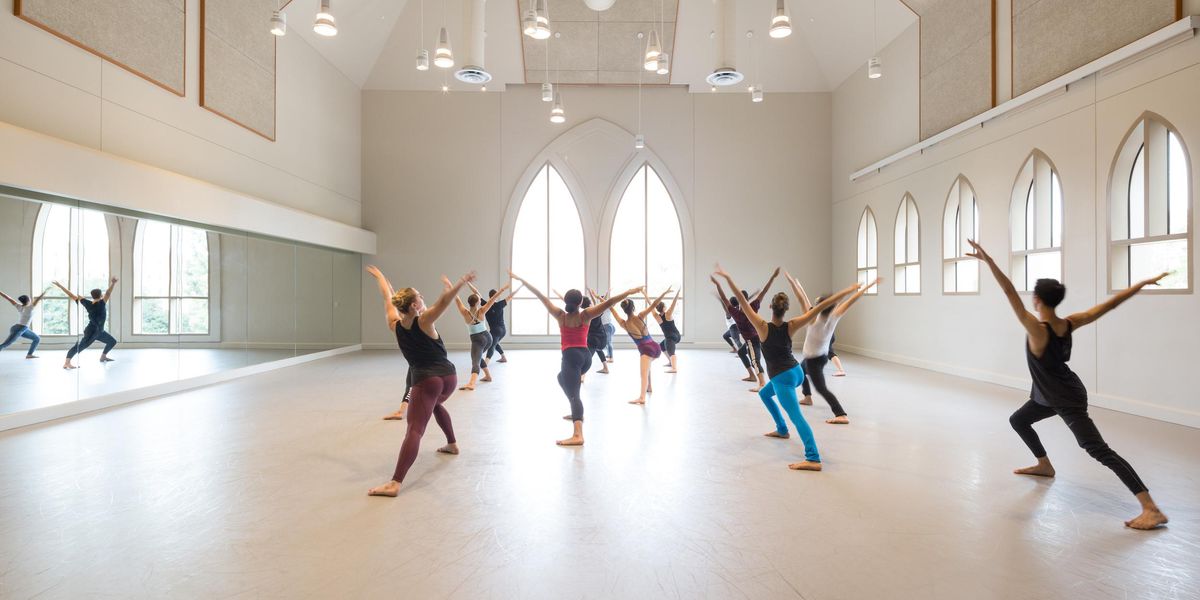Forsythe at BAM: Whatever is the opposite of facile
The word “beautiful” does not cross your mind as you watch William Forsythe’s Sider—until the last five minutes. Odd, willful, fractured, yes. But his fascinating choices do not amount to any sort of harmony. So after those sometimes exasperating qualities, when you see lilting, feathery arm movements, you’re taken by surprise. You think, “Ahhh, that’s beautiful” and the thought continues as you watch till the end.
Each Forsythe piece that has come to the Brooklyn Academy of Music creates its own world with its own hidden rules. In this case the basic rule is the rhythm of an Elizabethan play, which the dancers hear through tiny headphones while they are performing. They are also, I learned at a talk with Forsythe at BAM, listening to his in-the-moment instructions on the headphones (mostly to slow down or speed up). But I didn’t know that or see that.
Frances Chiaverini (center) in
Sider
Photo by Julieta Cervantes, Courtesy Bam
What I did see was a unique world made up of disparate elements. Some would regard this as a puzzle to “figure out.” But I tend to think, Who else would put big cardboard slats, medieval hoods, flickering fluorescent lights, a soft-to-ominous sound score, and 18 fabulous dancers together? No one but Forsythe, because he pushes the idea of coherence to the limit. Underneath, and under cover, Shakespeare has given it a skeletal structure.
The puzzle I do like to solve when watching a Forsythe ballet is to track the ways that it echoes past pieces.
In its hauling, heaving rambunctiousness, Sider is like Forsythe’s One Flat Thing, Reproduced. In that ballet, people scrambled through, over, and under 20 metal tables. The person-sized cardboard panels in Sider are about the same proportions as those table tops but have different properties. Both were loud when moved against the floor, but the corrugated cardboard flats are easier to lift and fall quietly.
Fabrice Mazliah in
Sider
Photo by Julieta Cervantes, Courtesy BAM
The fluorescent lights in Sider that flicker off and on remind me of the stage curtain that repeatedly descends mid-ballet in Artifact Suite, rudely cutting off our view of the dancing. In Sider, some bulbs suddenly go dark while others stay on, so it’s as jarring as a blackout but you can still see the dancing—it’s just very dim until those lights go back on.
The crazed delivery of a monologue in two opposite voices, carried out here by David Kern in a pink skullcap (and sometimes an added Elizabethan ruff collar), is reminiscent of Dana Caspersen alternating wildly exaggerated male and female voices while reciting Anne Carson’s poetry in Decreation.
What is completely different is the character given to Frances Chiaverini. A curious, undaunted Alice in a bizarre wonderland of obessive actions, she drifts and skips through, looking above, below, and beyond for clues. At one point an ominous sound grows louder and louder, while everyone crashes their siders (it’s a carpentry term for a flat surface) around her. Chiaverini is beleaguered but never loses her innocence. At the talk on Saturday, Forsythe revealed that the secret Elizabethan play is Hamlet, and Chiaverini is playing Ophelia. Her element is water, which explains why she was more fluid than the others. (See a video of the fabulous Frances Chiaverini at our cover shoot here.)
From left: Brigel Gjoka, Ander Zabala, and David Kern
Photo by Julieta Cervantes, Courtesy BAM.
What’s different too is the embedded love story between Chiaverini and protagonist Fabrice Mazliah. While David Kern is babbling in uber-theatrical gibberish on both sides of a sider, these two stand very close with a slat in between, seemingly unaware of each other, both facing the audience. She is stretching her face and mouth in all directions while he snaps his fingers. Somehow that wall comes down and they sit talking amiably, finally receding behind the panel as though ready for a kiss. I figure they are Hamlet and Ophelia getting to know each other.
Thom Willem’s score sets a low steady pulsation against a high whistling sound. Occasionally a clacking clap is thrown into the works. The dancers do not hear Willem’s sounds. We do, and Forsythe does, while he “conducts” them from wherever he is stationed. When all these sounds empty out, the sudden silence creates another kind of drama.
Toward the end, all 18 dancers lineup to bang on their own panels, as though drumming. The banging turns into tapping and then into a lovely wavelike motion. Finally we can take a breath. (At the talk, Forsythe referred to this section as “the concert.” And the word in the script they are hearing is “beautiful”—the exact word that came into my mind!)
The players exit one by one, leaving the same three onstage who began the piece: Chiavarini quietly manipulating two siders, Mazliah elbowing himself along the floor, and Kern lingering upstage with his own cardboard rectangle. They freeze again, in a moment that recalls the freeze in the opening scene. We recapture our own memory. Lights out—and this time it’s all the lights. We are left with a sense of a brief and hard-earned beauty.




